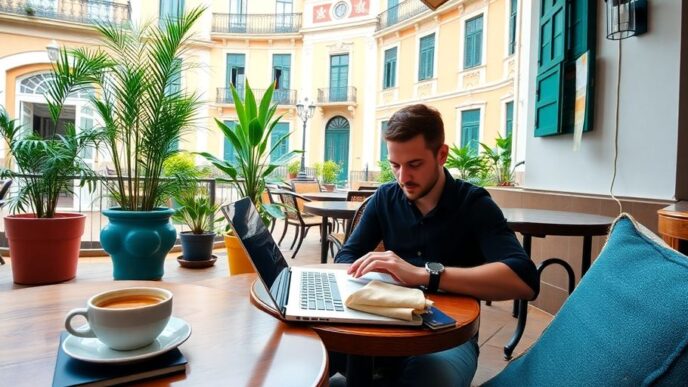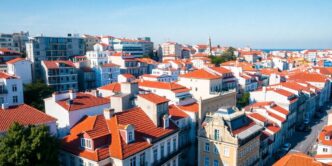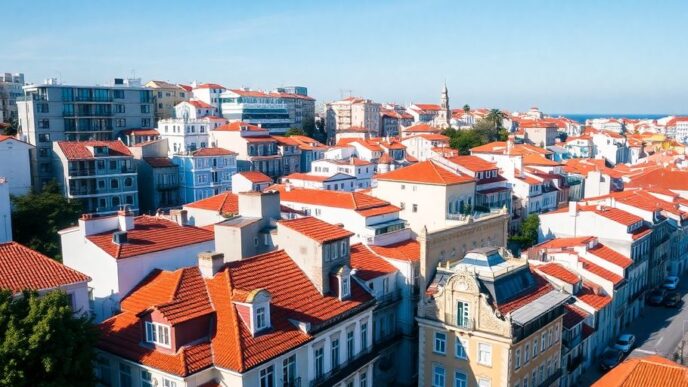Advancing Sustainable Architecture in Portugal

Innovative Eco-Friendly Design and Construction
Portugal’s commitment to sustainable architecture is evident in its innovative approach to eco-friendly design and construction. The nation’s architects and builders are increasingly focusing on energy efficiency, utilizing green building materials, and integrating renewable energy sources to create structures that are both aesthetically pleasing and environmentally responsible.
The use of green building materials is a cornerstone of this movement. These materials not only reduce the carbon footprint of construction but also improve indoor air quality, leading to healthier living and working environments. By prioritizing materials such as recycled content and low VOC products, Portugal is minimizing the impact on natural resources and setting a standard for sustainable construction practices.
Renewable energy integration is another key aspect of Portugal’s sustainable architecture. The adoption of solar, wind, and other clean energy sources helps to decrease reliance on fossil fuels and promotes a greener energy economy. This shift is not only beneficial for the environment but also for the long-term economic viability of the buildings.
Green infrastructure is also a significant component of Portugal’s sustainable urban planning. The creation of accessible green spaces and efficient water management systems contributes to resource conservation and enhances the quality of life for residents.
As Portugal continues to advance in sustainable architecture, it serves as an inspirational model for other nations, demonstrating the positive impacts that conscious design choices can have on both the environment and society.
Integration of Renewable Energy and Green Materials
Sustainability in Portugal is exemplified through the integration of renewable energy and green materials in its architecture. The country has made significant strides in reducing its reliance on fossil fuels by harnessing solar panels, wind turbines, and geothermal systems. These sustainable energy solutions not only contribute to a cleaner environment but also align with the global shift towards green energy.
Portugal’s commitment to sustainable architecture extends to the use of green building materials. Embracing environmentally friendly materials, such as those with low volatile organic compounds (VOCs) and recycled content, Portugal’s buildings are not only reducing their carbon footprint but also enhancing indoor air quality. This approach to construction reflects a broader dedication to resource conservation and the health of its inhabitants.
The integration of renewable energy and innovative materials in Portuguese architecture is a testament to the nation’s dedication to sustainability. It showcases a future-oriented mindset that prioritizes the well-being of both the environment and its people.
The following table highlights notable green buildings in Portugal that embody these principles:
| Building Name | Location | Notable Features |
|---|---|---|
| Bio Building | Guimar\u00e3es | Utilizes renewable resources, locally sourced materials, natural lighting |
| Museum of the Electric | Lisbon | Solar panels, natural light, rainwater reuse |
| Jo\u00e3o Francisco Building | Porto | Vertical gardens, green roofs, renewable energy sources |
Green Infrastructure and Urban Planning
Portugal’s urban landscapes are increasingly becoming a testament to the country’s dedication to sustainable development. The integration of green infrastructure into urban planning is a strategic approach that not only enhances the aesthetic appeal of cities but also contributes significantly to environmental conservation and public health. Accessible green spaces, such as parks and urban gardens, are not just recreational areas but also serve as vital components for biodiversity and climate regulation.
The following table outlines some of the key benefits associated with green infrastructure in Portugal’s urban planning:
| Benefit | Description |
|---|---|
| Clean Energy Promotion | Encourages the use of renewable energy sources within urban settings. |
| Greenhouse Gas Reduction | Contributes to lower emissions through carbon sequestration in green spaces. |
| Biodiversity Enhancement | Supports diverse ecosystems within the urban fabric. |
| Sustainable Urban Environment | Fosters a healthier lifestyle and reduces environmental footprints. |
By prioritizing green infrastructure, Portugal is not only addressing the immediate needs of its urban populations but also ensuring a resilient and sustainable future for its cities.
The João Francisco Building in Porto exemplifies this commitment, featuring vertical gardens and green roofs that purify the air and provide insulation, respectively, while also harnessing renewable energy sources. Such initiatives underscore the potential of sustainable architecture to revolutionize urban living, making it more sustainable and harmonious with nature.
Economic and Environmental Impacts of Green Buildings

Enhancing Quality of Life and Community Well-being
The pursuit of sustainability in architecture extends beyond environmental considerations to encompass social and economic dimensions that significantly enhance the quality of life and community well-being. Green buildings in Portugal are designed to provide healthier living environments, which contribute to improved physical and mental health for residents. The integration of natural light, improved air quality, and the use of non-toxic materials are key factors in creating spaces that foster well-being.
In Portugal, the commitment to sustainable architecture has also led to the development of urban parks and green spaces that serve as communal hubs. These areas are vital for social interaction, recreation, and the promotion of an active lifestyle. The urban park movement, with its objective to increase life quality in the modern city, is a testament to the country’s dedication to sustainability and city regeneration strategies.
The emphasis on sustainability in the built environment is not only about reducing carbon footprints but also about creating spaces that resonate with human comfort and social cohesion.
Furthermore, sustainable practices in architecture and urban planning are closely linked to economic benefits. Green buildings often result in lower operating costs due to energy efficiency and reduced waste. This economic advantage is passed on to residents and businesses, contributing to the overall economic health of communities. The table below illustrates some of the key indicators that reflect the positive impact of sustainable architecture on quality of life and economic well-being in Portugal.
Sustainability Indicators and Performance Monitoring
The pursuit of sustainability in Portugal is underpinned by a robust framework of indicators designed to monitor and evaluate the nation’s performance across various dimensions of sustainability. These indicators, informed by international organizations such as OMT and Eurostat, are crucial for assessing Portugal’s effectiveness as a sustainable tourist destination.
Resources such as the Tourism Strategy 2027 and the European Tourism System of Indicators for Sustainable Management at Destination Level (ETIS) provide structured guidance for sustainable practices. The Sustainable Tourism Indicator System (SITS) categorizes indicators into environmental, economic, and social aspects, offering a comprehensive view of sustainability efforts.
The integration of sustainability indicators into national strategies reflects Portugal’s commitment to a future where economic growth aligns with environmental stewardship and social well-being.
For instance, the Environmental Performance by Accommodations in Portugal report for 2022 highlights the adoption of sustainability best practices within the tourism sector. Additionally, the focus on reducing carbon emissions in air transport and the increasing use of sustainable aviation fuel are indicative of the proactive measures being taken to minimize environmental impact.
The Banco de Portugal’s Decarbonisation Programme, aiming for carbon neutrality by 2050, exemplifies the alignment of financial institutions with the nation’s sustainability goals. This initiative underscores the importance of cross-sector collaboration in achieving comprehensive and lasting sustainability outcomes.
Promoting Biodiversity Through Sustainable Practices
Portugal’s commitment to sustainability extends beyond the construction of green buildings; it encompasses a broader vision that includes the promotion of biodiversity. Green initiatives play a pivotal role in this vision, aiming to create a balance between development and the natural world. These initiatives are not just about preserving the environment but also about enhancing urban living, as seen in the LIFE Programme’s impact on nature. All over the EU, LIFE projects involve residents in designing and building cities with more green spaces, fewer hot spots, and accessible public transport.
The Institute for Nature Conservation and Biodiversity is at the forefront of these efforts, contributing significantly to the preservation of Portugal’s natural heritage. Through a variety of conservation measures, the protection of areas, and the management of invasive species, Portugal is working towards ensuring the long-term survival of its unique biodiversity.
Collaboration is key in these endeavors. The UNESCO Chair in Biodiversity and Conservation for Sustainable Development exemplifies this by serving as a platform for interdisciplinary research and innovative solutions. It fosters knowledge sharing and collaboration among researchers, policymakers, and practitioners worldwide, furthering the cause of biodiversity conservation.
Portugal’s dedication to sustainability and environmentalism is a testament to its forward-thinking approach to development. By integrating green infrastructure, prioritizing energy efficiency, and harnessing renewable energy, the country sets a commendable example for sustainable living. The benefits of such practices are manifold, including economic viability, enhanced quality of life, and the preservation of natural habitats.
As Portugal continues to innovate with sustainable architecture and eco-friendly design, it not only reduces its carbon footprint but also paves the way for a greener future. The commitment to sustainability is further reflected in the monitoring of sustainability indicators, ensuring that the nation’s progress aligns with international standards. Portugal’s journey towards sustainability is a blueprint for others to follow, demonstrating that environmental responsibility can go hand-in-hand with urban and economic development.













